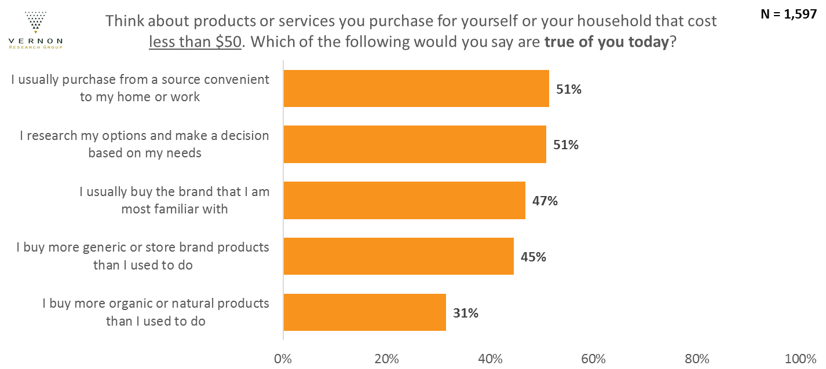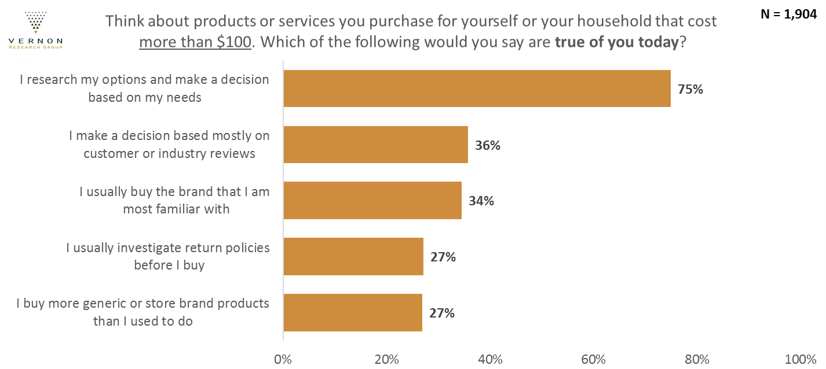Consumers make many decisions before purchasing a product or service. They decide:
- How much and what kind of information they need to make a purchase
- How they will obtain information about their options
- If they will comparison shop or not
- When they will make their purchase
- How they will make their purchase
- Where they will make their purchase
Consumer behavior around purchase behaviors can vary greatly between people and even within the same person for different types of products or services. Understanding the factors involved for your various types of customers, products, and services is essential to effective marketing.
Degree of involvement in purchase decisions
How deeply involved a consumer gets in the purchase decision process is related to how important the purchase is and how much information she needs to make the decision with confidence. This level of involvement can often vary more by consumer than it does by product. Some purchases, such as a new home, will feature a high level of involvement from almost all buyers due to the high cost, importance to the buyer, and risk for post-purchase issues. For many products and services, however, you may have some customers who consider it a routine purchase, others who buy on impulse, and still others who engage in extensive research and comparison before buying.
Headphones are a good example. One person may simply pick up a pair the next time they are in a drugstore or convenience store. Another person may hop on Amazon, check a few reviews and price options, and make a purchase. Yet another person may spend a week reviewing and comparing options from sites like Consumer Reports or PC Magazine, then visit an electronics store to try out their favorites before choosing one to buy.
Frequency of purchase impacts behaviors
Those who buy an item routinely usually have low involvement in the purchase process. Usually these are inexpensive purchases. They don’t always comparison shop and will simply buy their preferred brand. They often purchase at many different locations; convenience is a key factor. In a recent study conducted with the Iowa Opinion Panel, it was the behavior reported by most participants for purchases under $50.

These buyers are likely to pay attention to reminder marketing, new product features (e.g., flavors), bulk sales, and convenience shopping/merchandising. Mass marketing is often effective at keeping the brand top-of-mind for those routine purchases. Examples of typical routine/convenience purchases are laundry detergent, snacks, and car washes.
On the other hand, those who buy an item infrequently will usually compare options for quality, price, and style in the selection process. This might be conducted online, in person, or in both environments. If the product has a higher price tag, the review process will be longer and more in-depth. Electronics, cars, travel, and home replacement windows are a few examples. The type of marketing information that influences these buyers includes customer reviews, product specifications, guarantees, performance data, and product education.
Degree of desirability affects purchase behaviors

Apple has been masterful at taking advantage of this factor. If a product is perceived as offering a unique characteristic or a highly-desired brand identification, there are consumers who are willing to make a special purchase effort and forgo typical comparison and price-shopping, even for high-ticket items. What they are often willing to invest, however, is time. Time to wait in line or time to travel a distance to reach a retailer/dealer. Lamborghini has only six dealerships in the U.S. and Hermes reserves sales of some of its highest-priced bags to their few physical stores only. Marketing for these types of purchases usually includes carefully targeted promotions.
Prior knowledge of or desire for product
If a brand new technology, service, or product enters the market, it often requires more aggressive advertising and personal selling to be considered. Most consumers will hesitate to try something new or unknown. This is also true of purchases that many people avoid making such as life insurance or hearing aids. Marketing for unknown or unsought products needs to be educational, relevant, and persuasive.
Purchase behaviors change depending on price
As noted a few times already, the price of the purchase often affects the consideration and buying process. Some of the common things consumers do when considering a purchase over $100 include expected behaviors like researching options but also less obvious actions such as investigating return policies before buying. These behaviors can differ from how they act when making small purchases. For example, only 25% reported buying more expensive items from outlets convenient to their home or work while 52% engage in that behavior for items under $50.
Below are the top purchase activities reported by those purchasing items over $100 in our recent research.

When creating or updating your marketing personas and marketing plans, be sure to consider how purchase consideration behaviors play a role for all of your products or services. Most likely, they are not the same and understanding the differences will lead to greater results.
Interested in seeing more data insights on this topic?
Click below to view the full report on purchase behaviors for products priced under $50 and products priced over $100, including statistically-significant differences between the two and for gender and age. It was conducted with more than 1,500 consumers in April and July, 2019.
https://www.vernonresearch.com/wp-content/uploads/2019/07/Shopping-Behavior-Changes-1.pdf
Do you have questions about how research can help you understand and leverage your customer purchase behaviors? We love to share our knowledge and ideas. Get in touch.

